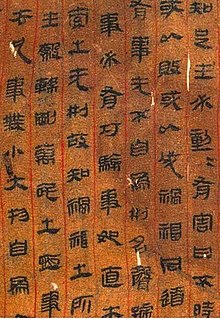
The Huangdi Sijing (simplified Chinese: 黄帝四经; traditional Chinese: 黃帝四經; pinyin: Huángdì sìjīng; lit. "Yellow Emperor's Four Classics") are long-lost Chinese texts, manuscripts of which were discovered among the Mawangdui Silk Texts in 1973. Also known as the Huang-Lao boshu (simplified Chinese: 黄老帛书; traditional Chinese: 黃老帛書; pinyin: Huáng-Lǎo bóshū; lit. "Huang-Lao Silk Texts"), they are thought by modern scholars to reflect a lost branch of early syncretist Daoism, referred to as the "Huang–Lao school of thought" named after the legendary Huangdi (黃帝 the "Yellow Emperor") and Laozi (老子 "Master Lao"). One finds in it "technical jargon" derived of Taoism, Legalism, Confucianism and Mohism.[1]
© MMXXIII Rich X Search. We shall prevail. All rights reserved. Rich X Search
